Impact of Fintech on Liquidity in Global Trade & Supply Chain Finance
VerifiedAdded on 2023/04/22
|31
|6196
|67
Report
AI Summary
This report investigates the impact of financial technology (fintech) on liquidity within global supply chains, highlighting the limitations of traditional banking platforms in processing modern financial transactions. Fintech facilitates faster, real-time money transfers, benefiting ventures and investors alike. The study explores fintech's role in international trade and supply chain finance, emphasizing its ability to enhance liquidity and profitability for suppliers by enabling quicker payments and access to broader markets. It also addresses challenges such as cyber threats and money laundering, suggesting future research should focus on minimizing these issues. The report concludes that fintech's real-time capabilities have revolutionized financial operations, while also acknowledging the need for ongoing improvements to address its inherent risks and maximize its potential.

Running head: FINTECH AND LIQUIDITY
Fintech and Liquidity
Name of the Student:
Name of the University:
Author Note:
Fintech and Liquidity
Name of the Student:
Name of the University:
Author Note:
Paraphrase This Document
Need a fresh take? Get an instant paraphrase of this document with our AI Paraphraser
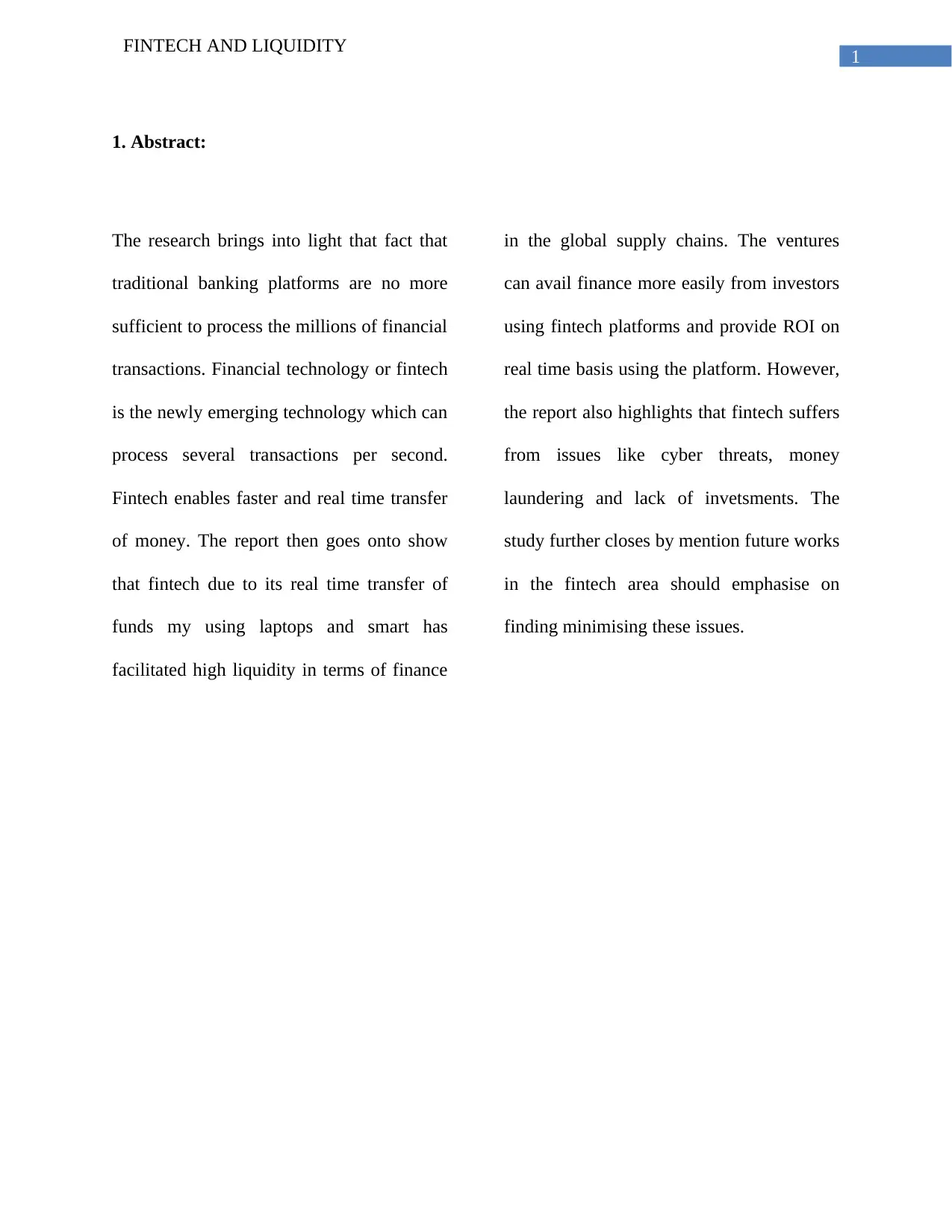
1
FINTECH AND LIQUIDITY
1. Abstract:
The research brings into light that fact that
traditional banking platforms are no more
sufficient to process the millions of financial
transactions. Financial technology or fintech
is the newly emerging technology which can
process several transactions per second.
Fintech enables faster and real time transfer
of money. The report then goes onto show
that fintech due to its real time transfer of
funds my using laptops and smart has
facilitated high liquidity in terms of finance
in the global supply chains. The ventures
can avail finance more easily from investors
using fintech platforms and provide ROI on
real time basis using the platform. However,
the report also highlights that fintech suffers
from issues like cyber threats, money
laundering and lack of invetsments. The
study further closes by mention future works
in the fintech area should emphasise on
finding minimising these issues.
FINTECH AND LIQUIDITY
1. Abstract:
The research brings into light that fact that
traditional banking platforms are no more
sufficient to process the millions of financial
transactions. Financial technology or fintech
is the newly emerging technology which can
process several transactions per second.
Fintech enables faster and real time transfer
of money. The report then goes onto show
that fintech due to its real time transfer of
funds my using laptops and smart has
facilitated high liquidity in terms of finance
in the global supply chains. The ventures
can avail finance more easily from investors
using fintech platforms and provide ROI on
real time basis using the platform. However,
the report also highlights that fintech suffers
from issues like cyber threats, money
laundering and lack of invetsments. The
study further closes by mention future works
in the fintech area should emphasise on
finding minimising these issues.
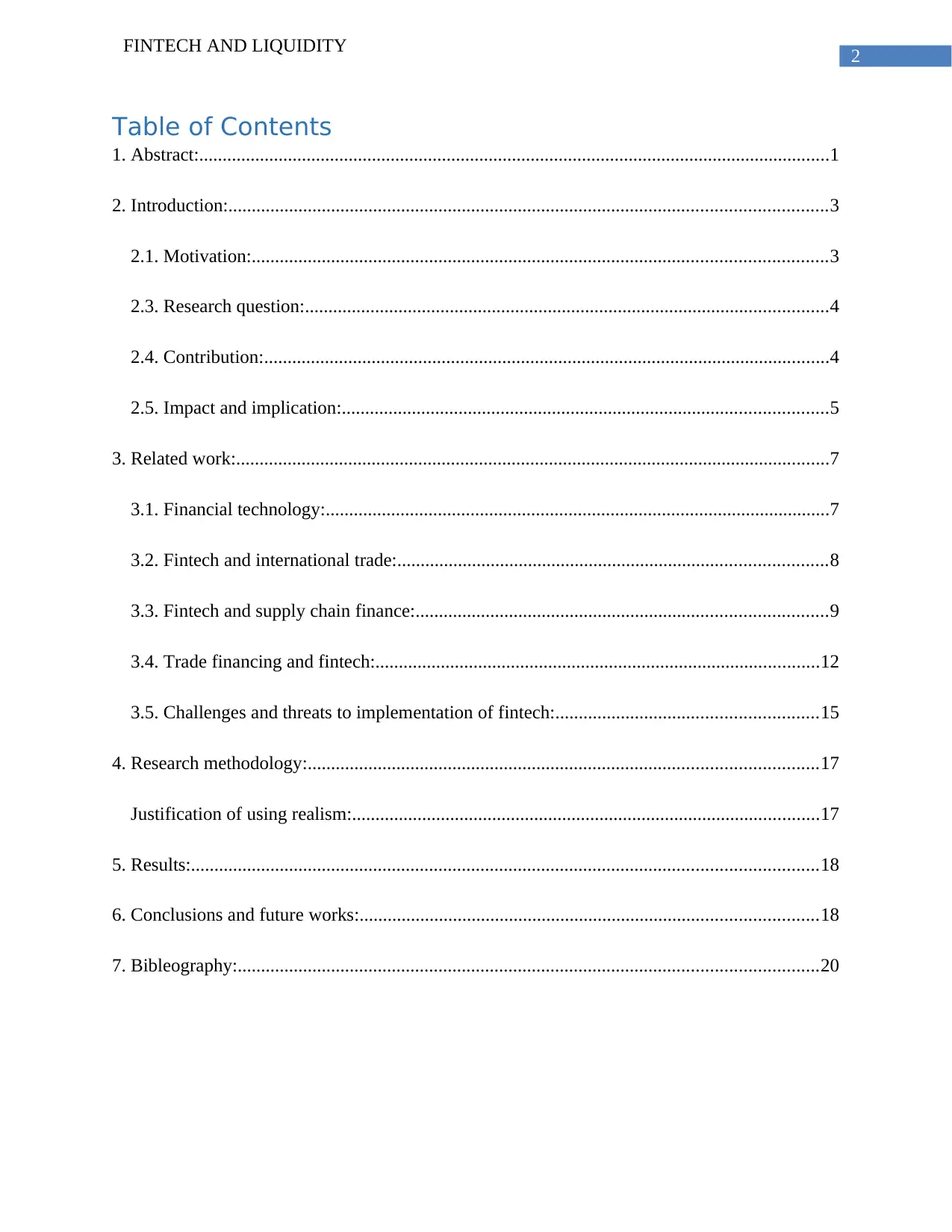
2
FINTECH AND LIQUIDITY
Table of Contents
1. Abstract:.......................................................................................................................................1
2. Introduction:................................................................................................................................3
2.1. Motivation:...........................................................................................................................3
2.3. Research question:................................................................................................................4
2.4. Contribution:.........................................................................................................................4
2.5. Impact and implication:........................................................................................................5
3. Related work:...............................................................................................................................7
3.1. Financial technology:............................................................................................................7
3.2. Fintech and international trade:............................................................................................8
3.3. Fintech and supply chain finance:........................................................................................9
3.4. Trade financing and fintech:...............................................................................................12
3.5. Challenges and threats to implementation of fintech:........................................................15
4. Research methodology:.............................................................................................................17
Justification of using realism:....................................................................................................17
5. Results:......................................................................................................................................18
6. Conclusions and future works:..................................................................................................18
7. Bibleography:............................................................................................................................20
FINTECH AND LIQUIDITY
Table of Contents
1. Abstract:.......................................................................................................................................1
2. Introduction:................................................................................................................................3
2.1. Motivation:...........................................................................................................................3
2.3. Research question:................................................................................................................4
2.4. Contribution:.........................................................................................................................4
2.5. Impact and implication:........................................................................................................5
3. Related work:...............................................................................................................................7
3.1. Financial technology:............................................................................................................7
3.2. Fintech and international trade:............................................................................................8
3.3. Fintech and supply chain finance:........................................................................................9
3.4. Trade financing and fintech:...............................................................................................12
3.5. Challenges and threats to implementation of fintech:........................................................15
4. Research methodology:.............................................................................................................17
Justification of using realism:....................................................................................................17
5. Results:......................................................................................................................................18
6. Conclusions and future works:..................................................................................................18
7. Bibleography:............................................................................................................................20
⊘ This is a preview!⊘
Do you want full access?
Subscribe today to unlock all pages.

Trusted by 1+ million students worldwide
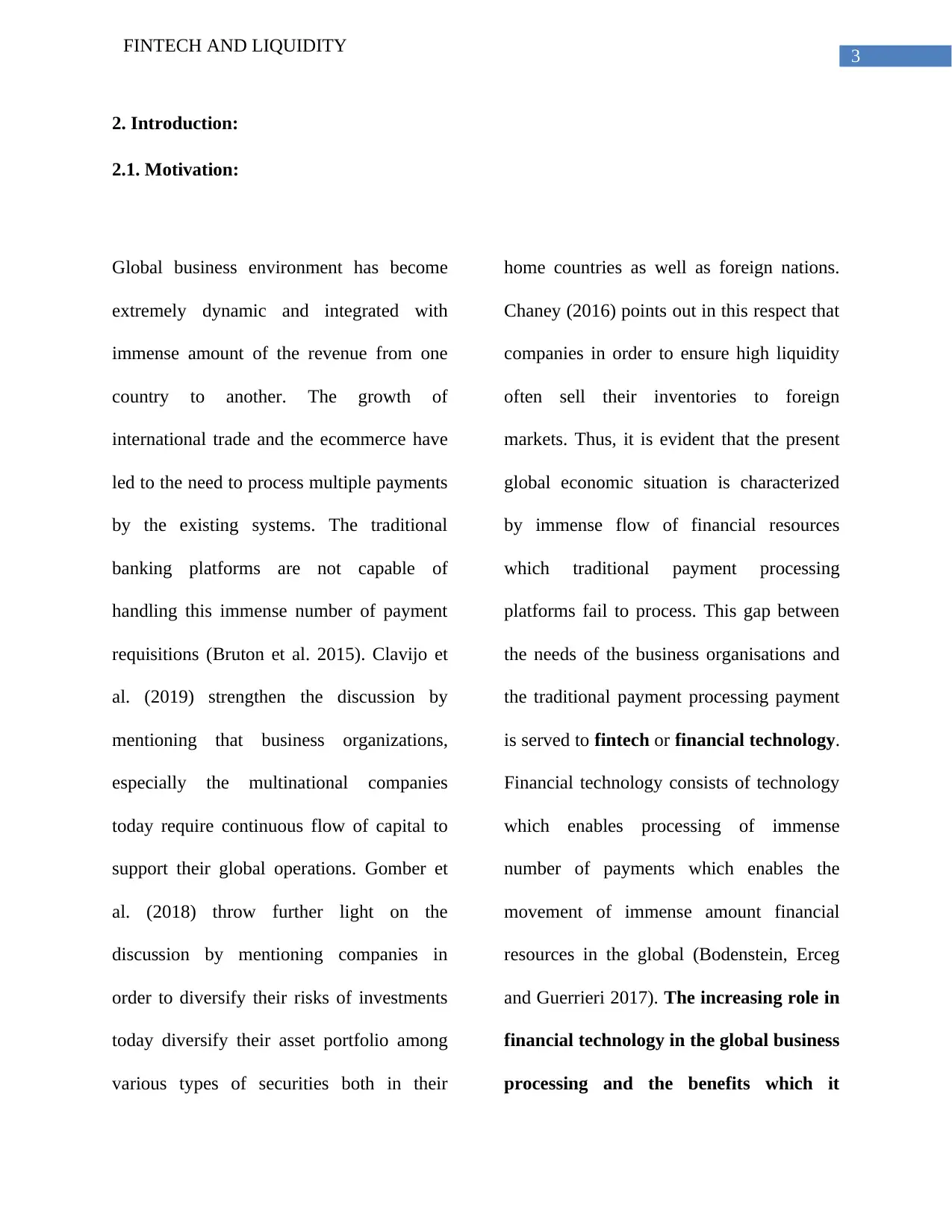
3
FINTECH AND LIQUIDITY
2. Introduction:
2.1. Motivation:
Global business environment has become
extremely dynamic and integrated with
immense amount of the revenue from one
country to another. The growth of
international trade and the ecommerce have
led to the need to process multiple payments
by the existing systems. The traditional
banking platforms are not capable of
handling this immense number of payment
requisitions (Bruton et al. 2015). Clavijo et
al. (2019) strengthen the discussion by
mentioning that business organizations,
especially the multinational companies
today require continuous flow of capital to
support their global operations. Gomber et
al. (2018) throw further light on the
discussion by mentioning companies in
order to diversify their risks of investments
today diversify their asset portfolio among
various types of securities both in their
home countries as well as foreign nations.
Chaney (2016) points out in this respect that
companies in order to ensure high liquidity
often sell their inventories to foreign
markets. Thus, it is evident that the present
global economic situation is characterized
by immense flow of financial resources
which traditional payment processing
platforms fail to process. This gap between
the needs of the business organisations and
the traditional payment processing payment
is served to fintech or financial technology.
Financial technology consists of technology
which enables processing of immense
number of payments which enables the
movement of immense amount financial
resources in the global (Bodenstein, Erceg
and Guerrieri 2017). The increasing role in
financial technology in the global business
processing and the benefits which it
FINTECH AND LIQUIDITY
2. Introduction:
2.1. Motivation:
Global business environment has become
extremely dynamic and integrated with
immense amount of the revenue from one
country to another. The growth of
international trade and the ecommerce have
led to the need to process multiple payments
by the existing systems. The traditional
banking platforms are not capable of
handling this immense number of payment
requisitions (Bruton et al. 2015). Clavijo et
al. (2019) strengthen the discussion by
mentioning that business organizations,
especially the multinational companies
today require continuous flow of capital to
support their global operations. Gomber et
al. (2018) throw further light on the
discussion by mentioning companies in
order to diversify their risks of investments
today diversify their asset portfolio among
various types of securities both in their
home countries as well as foreign nations.
Chaney (2016) points out in this respect that
companies in order to ensure high liquidity
often sell their inventories to foreign
markets. Thus, it is evident that the present
global economic situation is characterized
by immense flow of financial resources
which traditional payment processing
platforms fail to process. This gap between
the needs of the business organisations and
the traditional payment processing payment
is served to fintech or financial technology.
Financial technology consists of technology
which enables processing of immense
number of payments which enables the
movement of immense amount financial
resources in the global (Bodenstein, Erceg
and Guerrieri 2017). The increasing role in
financial technology in the global business
processing and the benefits which it
Paraphrase This Document
Need a fresh take? Get an instant paraphrase of this document with our AI Paraphraser
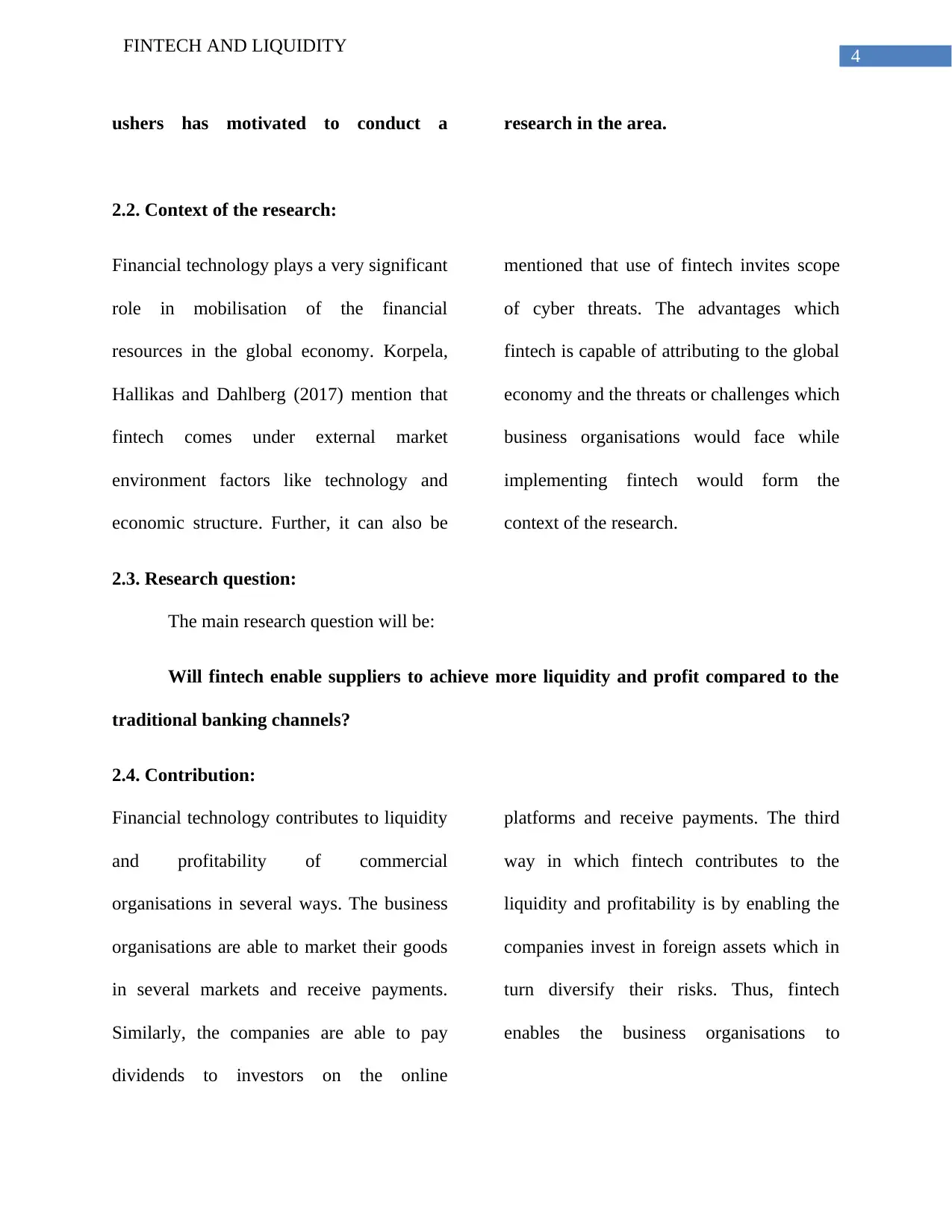
4
FINTECH AND LIQUIDITY
ushers has motivated to conduct a research in the area.
2.2. Context of the research:
Financial technology plays a very significant
role in mobilisation of the financial
resources in the global economy. Korpela,
Hallikas and Dahlberg (2017) mention that
fintech comes under external market
environment factors like technology and
economic structure. Further, it can also be
mentioned that use of fintech invites scope
of cyber threats. The advantages which
fintech is capable of attributing to the global
economy and the threats or challenges which
business organisations would face while
implementing fintech would form the
context of the research.
2.3. Research question:
The main research question will be:
Will fintech enable suppliers to achieve more liquidity and profit compared to the
traditional banking channels?
2.4. Contribution:
Financial technology contributes to liquidity
and profitability of commercial
organisations in several ways. The business
organisations are able to market their goods
in several markets and receive payments.
Similarly, the companies are able to pay
dividends to investors on the online
platforms and receive payments. The third
way in which fintech contributes to the
liquidity and profitability is by enabling the
companies invest in foreign assets which in
turn diversify their risks. Thus, fintech
enables the business organisations to
FINTECH AND LIQUIDITY
ushers has motivated to conduct a research in the area.
2.2. Context of the research:
Financial technology plays a very significant
role in mobilisation of the financial
resources in the global economy. Korpela,
Hallikas and Dahlberg (2017) mention that
fintech comes under external market
environment factors like technology and
economic structure. Further, it can also be
mentioned that use of fintech invites scope
of cyber threats. The advantages which
fintech is capable of attributing to the global
economy and the threats or challenges which
business organisations would face while
implementing fintech would form the
context of the research.
2.3. Research question:
The main research question will be:
Will fintech enable suppliers to achieve more liquidity and profit compared to the
traditional banking channels?
2.4. Contribution:
Financial technology contributes to liquidity
and profitability of commercial
organisations in several ways. The business
organisations are able to market their goods
in several markets and receive payments.
Similarly, the companies are able to pay
dividends to investors on the online
platforms and receive payments. The third
way in which fintech contributes to the
liquidity and profitability is by enabling the
companies invest in foreign assets which in
turn diversify their risks. Thus, fintech
enables the business organisations to
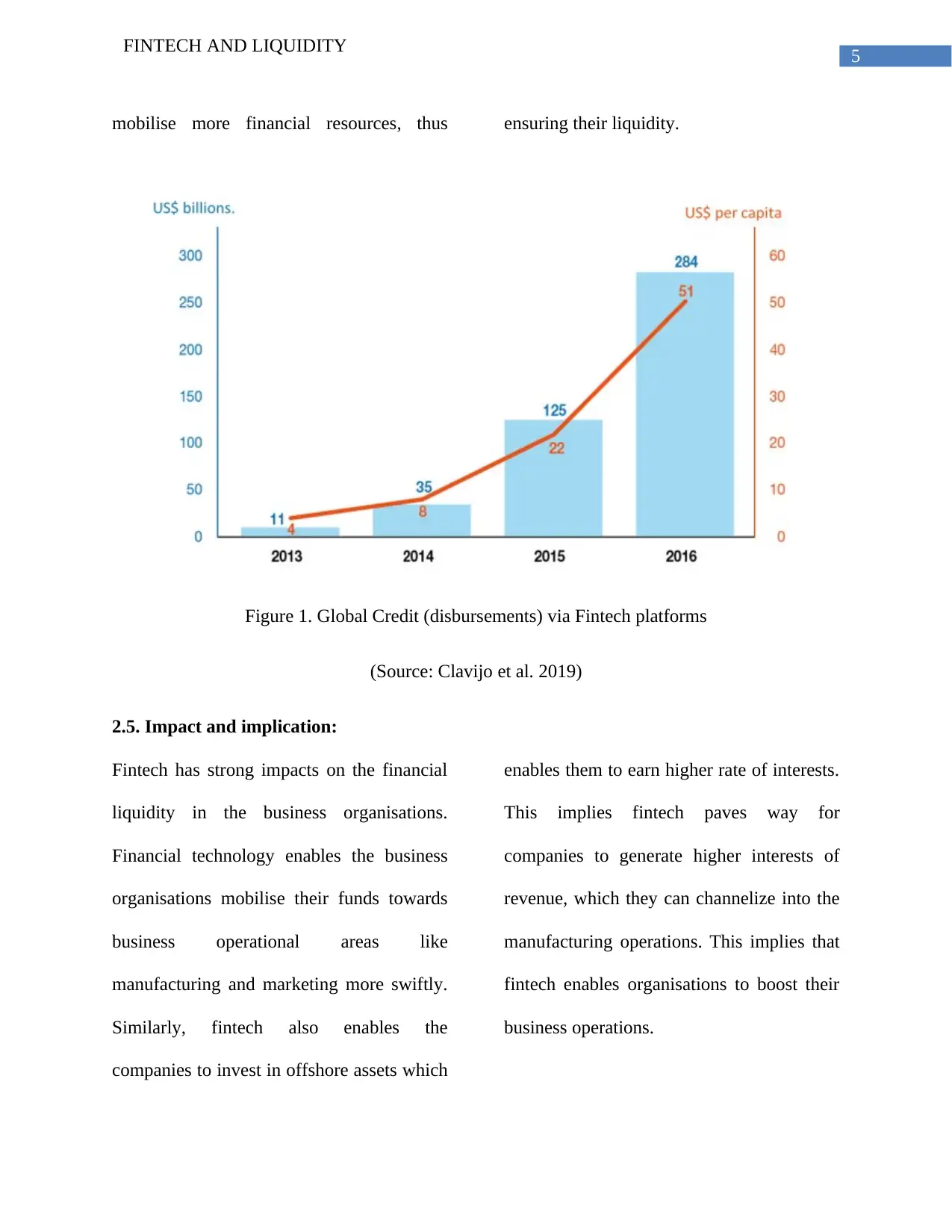
5
FINTECH AND LIQUIDITY
mobilise more financial resources, thus ensuring their liquidity.
Figure 1. Global Credit (disbursements) via Fintech platforms
(Source: Clavijo et al. 2019)
2.5. Impact and implication:
Fintech has strong impacts on the financial
liquidity in the business organisations.
Financial technology enables the business
organisations mobilise their funds towards
business operational areas like
manufacturing and marketing more swiftly.
Similarly, fintech also enables the
companies to invest in offshore assets which
enables them to earn higher rate of interests.
This implies fintech paves way for
companies to generate higher interests of
revenue, which they can channelize into the
manufacturing operations. This implies that
fintech enables organisations to boost their
business operations.
FINTECH AND LIQUIDITY
mobilise more financial resources, thus ensuring their liquidity.
Figure 1. Global Credit (disbursements) via Fintech platforms
(Source: Clavijo et al. 2019)
2.5. Impact and implication:
Fintech has strong impacts on the financial
liquidity in the business organisations.
Financial technology enables the business
organisations mobilise their funds towards
business operational areas like
manufacturing and marketing more swiftly.
Similarly, fintech also enables the
companies to invest in offshore assets which
enables them to earn higher rate of interests.
This implies fintech paves way for
companies to generate higher interests of
revenue, which they can channelize into the
manufacturing operations. This implies that
fintech enables organisations to boost their
business operations.
⊘ This is a preview!⊘
Do you want full access?
Subscribe today to unlock all pages.

Trusted by 1+ million students worldwide
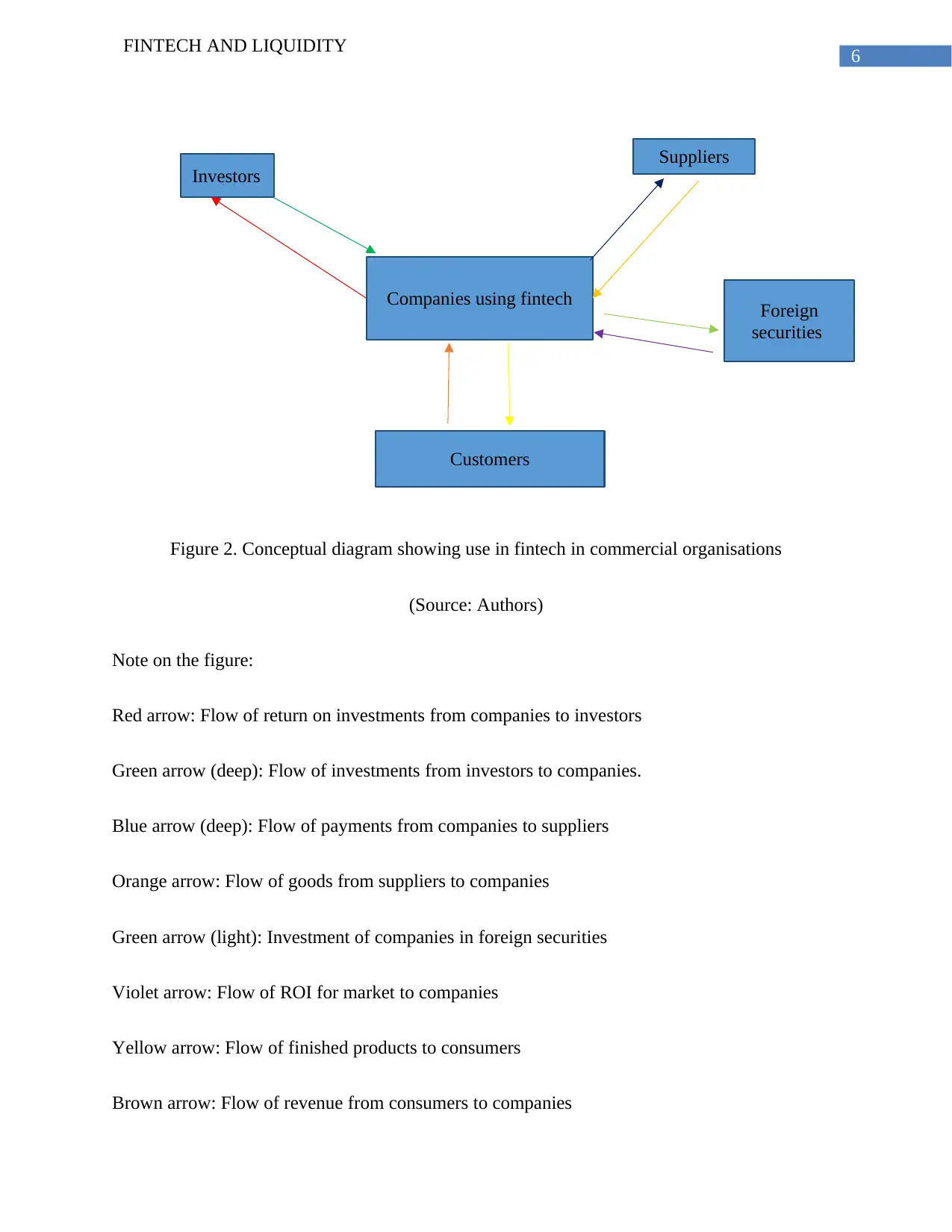
6
FINTECH AND LIQUIDITY
Investors
Companies using fintech
Suppliers
Customers
Foreign
securities
Figure 2. Conceptual diagram showing use in fintech in commercial organisations
(Source: Authors)
Note on the figure:
Red arrow: Flow of return on investments from companies to investors
Green arrow (deep): Flow of investments from investors to companies.
Blue arrow (deep): Flow of payments from companies to suppliers
Orange arrow: Flow of goods from suppliers to companies
Green arrow (light): Investment of companies in foreign securities
Violet arrow: Flow of ROI for market to companies
Yellow arrow: Flow of finished products to consumers
Brown arrow: Flow of revenue from consumers to companies
FINTECH AND LIQUIDITY
Investors
Companies using fintech
Suppliers
Customers
Foreign
securities
Figure 2. Conceptual diagram showing use in fintech in commercial organisations
(Source: Authors)
Note on the figure:
Red arrow: Flow of return on investments from companies to investors
Green arrow (deep): Flow of investments from investors to companies.
Blue arrow (deep): Flow of payments from companies to suppliers
Orange arrow: Flow of goods from suppliers to companies
Green arrow (light): Investment of companies in foreign securities
Violet arrow: Flow of ROI for market to companies
Yellow arrow: Flow of finished products to consumers
Brown arrow: Flow of revenue from consumers to companies
Paraphrase This Document
Need a fresh take? Get an instant paraphrase of this document with our AI Paraphraser
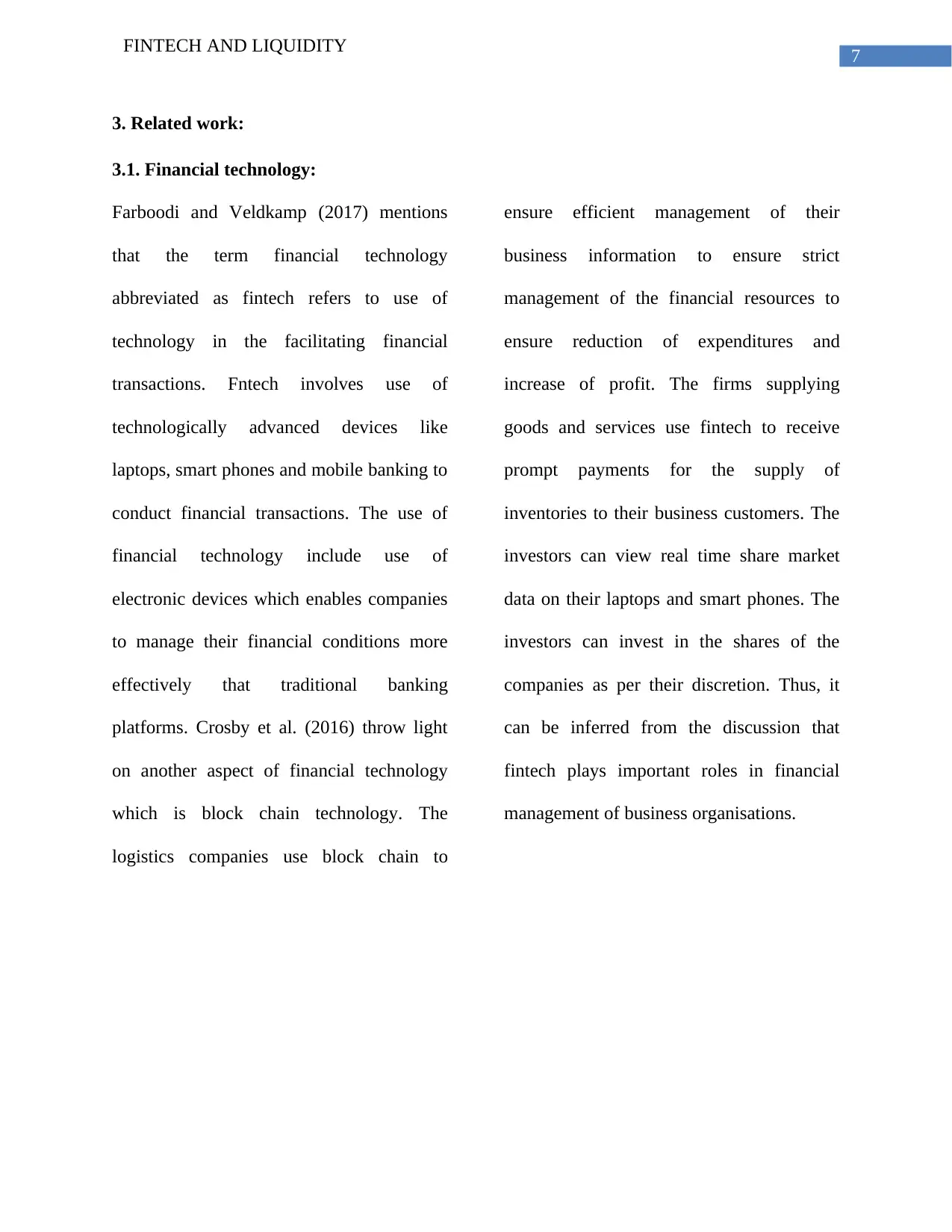
7
FINTECH AND LIQUIDITY
3. Related work:
3.1. Financial technology:
Farboodi and Veldkamp (2017) mentions
that the term financial technology
abbreviated as fintech refers to use of
technology in the facilitating financial
transactions. Fntech involves use of
technologically advanced devices like
laptops, smart phones and mobile banking to
conduct financial transactions. The use of
financial technology include use of
electronic devices which enables companies
to manage their financial conditions more
effectively that traditional banking
platforms. Crosby et al. (2016) throw light
on another aspect of financial technology
which is block chain technology. The
logistics companies use block chain to
ensure efficient management of their
business information to ensure strict
management of the financial resources to
ensure reduction of expenditures and
increase of profit. The firms supplying
goods and services use fintech to receive
prompt payments for the supply of
inventories to their business customers. The
investors can view real time share market
data on their laptops and smart phones. The
investors can invest in the shares of the
companies as per their discretion. Thus, it
can be inferred from the discussion that
fintech plays important roles in financial
management of business organisations.
FINTECH AND LIQUIDITY
3. Related work:
3.1. Financial technology:
Farboodi and Veldkamp (2017) mentions
that the term financial technology
abbreviated as fintech refers to use of
technology in the facilitating financial
transactions. Fntech involves use of
technologically advanced devices like
laptops, smart phones and mobile banking to
conduct financial transactions. The use of
financial technology include use of
electronic devices which enables companies
to manage their financial conditions more
effectively that traditional banking
platforms. Crosby et al. (2016) throw light
on another aspect of financial technology
which is block chain technology. The
logistics companies use block chain to
ensure efficient management of their
business information to ensure strict
management of the financial resources to
ensure reduction of expenditures and
increase of profit. The firms supplying
goods and services use fintech to receive
prompt payments for the supply of
inventories to their business customers. The
investors can view real time share market
data on their laptops and smart phones. The
investors can invest in the shares of the
companies as per their discretion. Thus, it
can be inferred from the discussion that
fintech plays important roles in financial
management of business organisations.
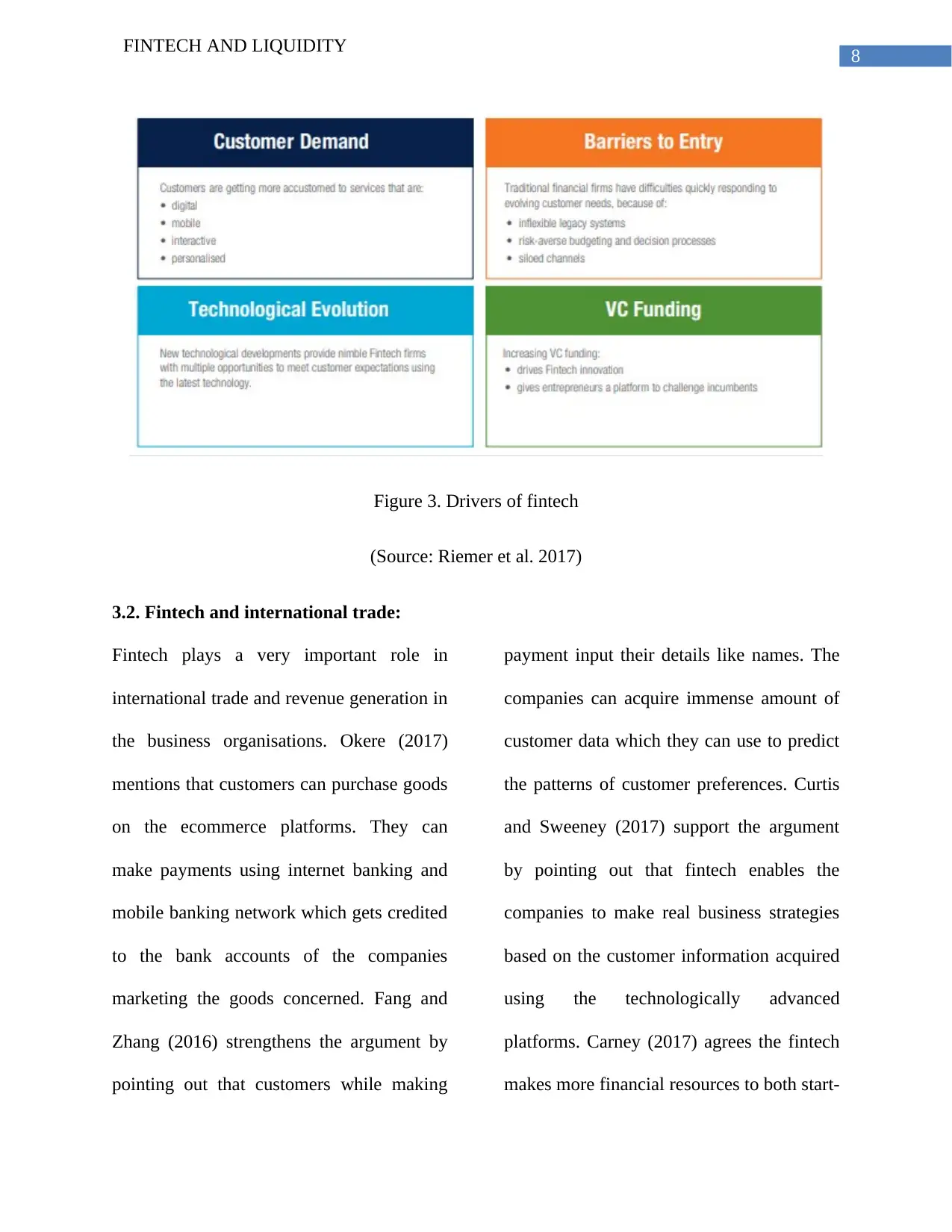
8
FINTECH AND LIQUIDITY
Figure 3. Drivers of fintech
(Source: Riemer et al. 2017)
3.2. Fintech and international trade:
Fintech plays a very important role in
international trade and revenue generation in
the business organisations. Okere (2017)
mentions that customers can purchase goods
on the ecommerce platforms. They can
make payments using internet banking and
mobile banking network which gets credited
to the bank accounts of the companies
marketing the goods concerned. Fang and
Zhang (2016) strengthens the argument by
pointing out that customers while making
payment input their details like names. The
companies can acquire immense amount of
customer data which they can use to predict
the patterns of customer preferences. Curtis
and Sweeney (2017) support the argument
by pointing out that fintech enables the
companies to make real business strategies
based on the customer information acquired
using the technologically advanced
platforms. Carney (2017) agrees the fintech
makes more financial resources to both start-
FINTECH AND LIQUIDITY
Figure 3. Drivers of fintech
(Source: Riemer et al. 2017)
3.2. Fintech and international trade:
Fintech plays a very important role in
international trade and revenue generation in
the business organisations. Okere (2017)
mentions that customers can purchase goods
on the ecommerce platforms. They can
make payments using internet banking and
mobile banking network which gets credited
to the bank accounts of the companies
marketing the goods concerned. Fang and
Zhang (2016) strengthens the argument by
pointing out that customers while making
payment input their details like names. The
companies can acquire immense amount of
customer data which they can use to predict
the patterns of customer preferences. Curtis
and Sweeney (2017) support the argument
by pointing out that fintech enables the
companies to make real business strategies
based on the customer information acquired
using the technologically advanced
platforms. Carney (2017) agrees the fintech
makes more financial resources to both start-
⊘ This is a preview!⊘
Do you want full access?
Subscribe today to unlock all pages.

Trusted by 1+ million students worldwide
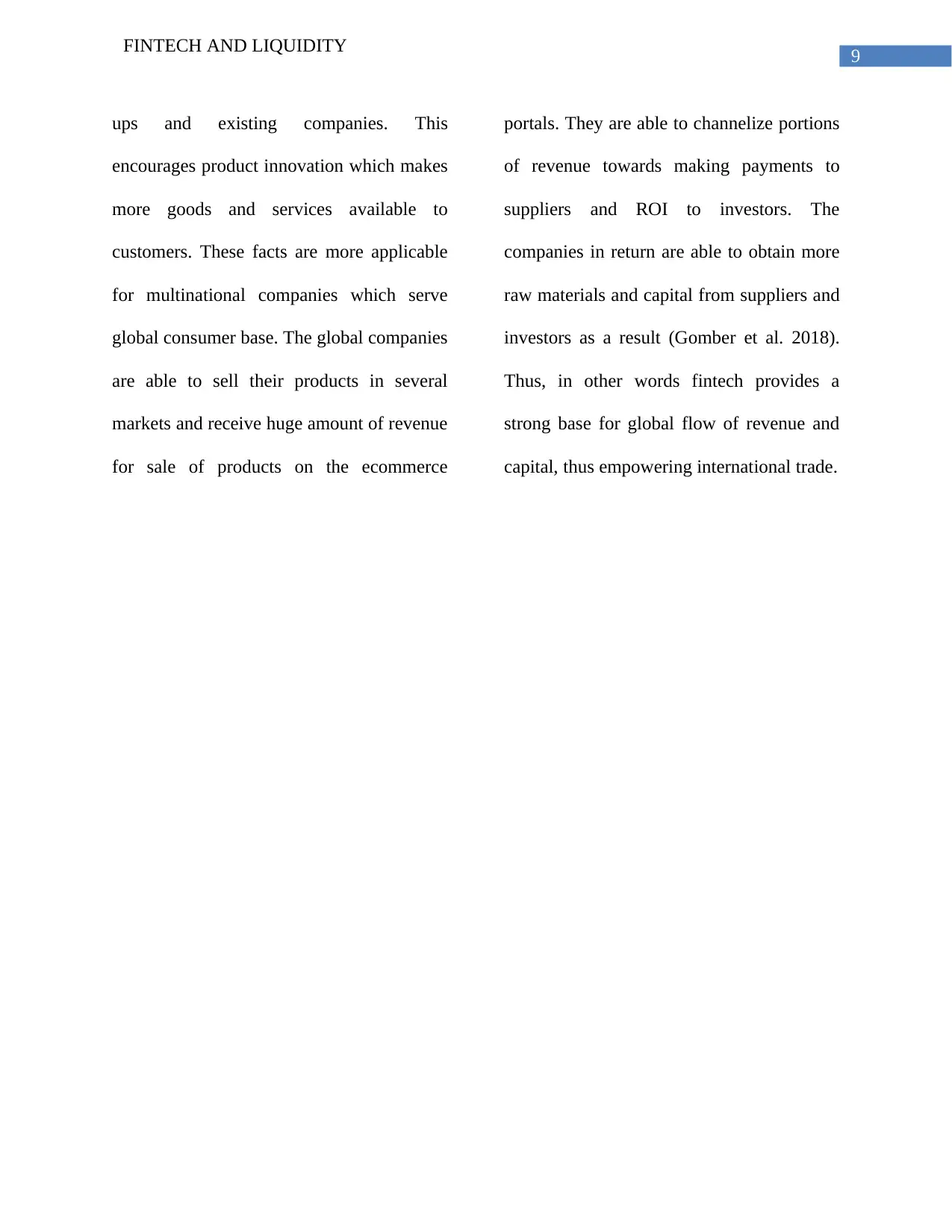
9
FINTECH AND LIQUIDITY
ups and existing companies. This
encourages product innovation which makes
more goods and services available to
customers. These facts are more applicable
for multinational companies which serve
global consumer base. The global companies
are able to sell their products in several
markets and receive huge amount of revenue
for sale of products on the ecommerce
portals. They are able to channelize portions
of revenue towards making payments to
suppliers and ROI to investors. The
companies in return are able to obtain more
raw materials and capital from suppliers and
investors as a result (Gomber et al. 2018).
Thus, in other words fintech provides a
strong base for global flow of revenue and
capital, thus empowering international trade.
FINTECH AND LIQUIDITY
ups and existing companies. This
encourages product innovation which makes
more goods and services available to
customers. These facts are more applicable
for multinational companies which serve
global consumer base. The global companies
are able to sell their products in several
markets and receive huge amount of revenue
for sale of products on the ecommerce
portals. They are able to channelize portions
of revenue towards making payments to
suppliers and ROI to investors. The
companies in return are able to obtain more
raw materials and capital from suppliers and
investors as a result (Gomber et al. 2018).
Thus, in other words fintech provides a
strong base for global flow of revenue and
capital, thus empowering international trade.
Paraphrase This Document
Need a fresh take? Get an instant paraphrase of this document with our AI Paraphraser
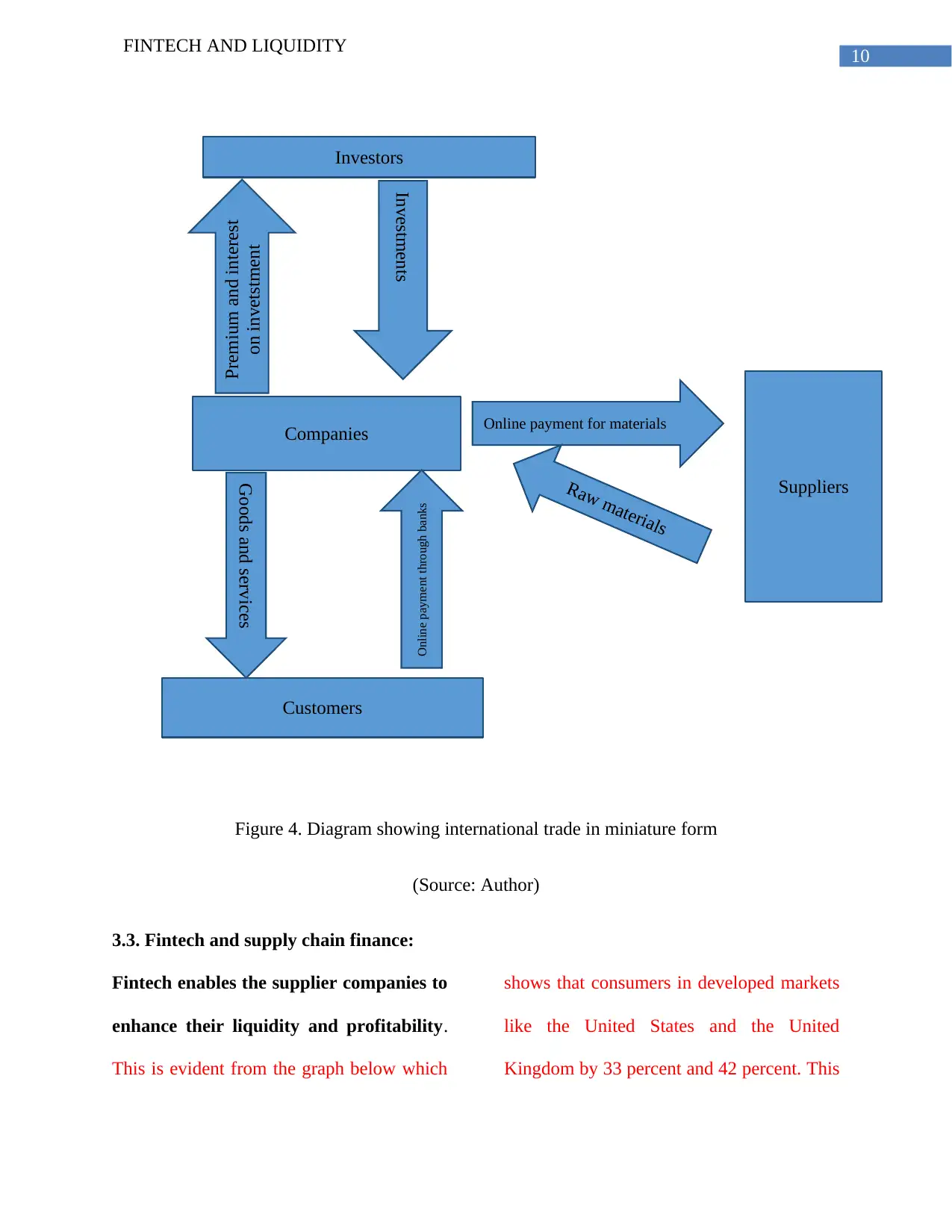
10
FINTECH AND LIQUIDITY
Companies
Goods and services
Customers
Online payment through banks
Premium and interest
on invetstment
Investors Investments
Suppliers
Online payment for materials
Raw materials
Figure 4. Diagram showing international trade in miniature form
(Source: Author)
3.3. Fintech and supply chain finance:
Fintech enables the supplier companies to
enhance their liquidity and profitability.
This is evident from the graph below which
shows that consumers in developed markets
like the United States and the United
Kingdom by 33 percent and 42 percent. This
FINTECH AND LIQUIDITY
Companies
Goods and services
Customers
Online payment through banks
Premium and interest
on invetstment
Investors Investments
Suppliers
Online payment for materials
Raw materials
Figure 4. Diagram showing international trade in miniature form
(Source: Author)
3.3. Fintech and supply chain finance:
Fintech enables the supplier companies to
enhance their liquidity and profitability.
This is evident from the graph below which
shows that consumers in developed markets
like the United States and the United
Kingdom by 33 percent and 42 percent. This
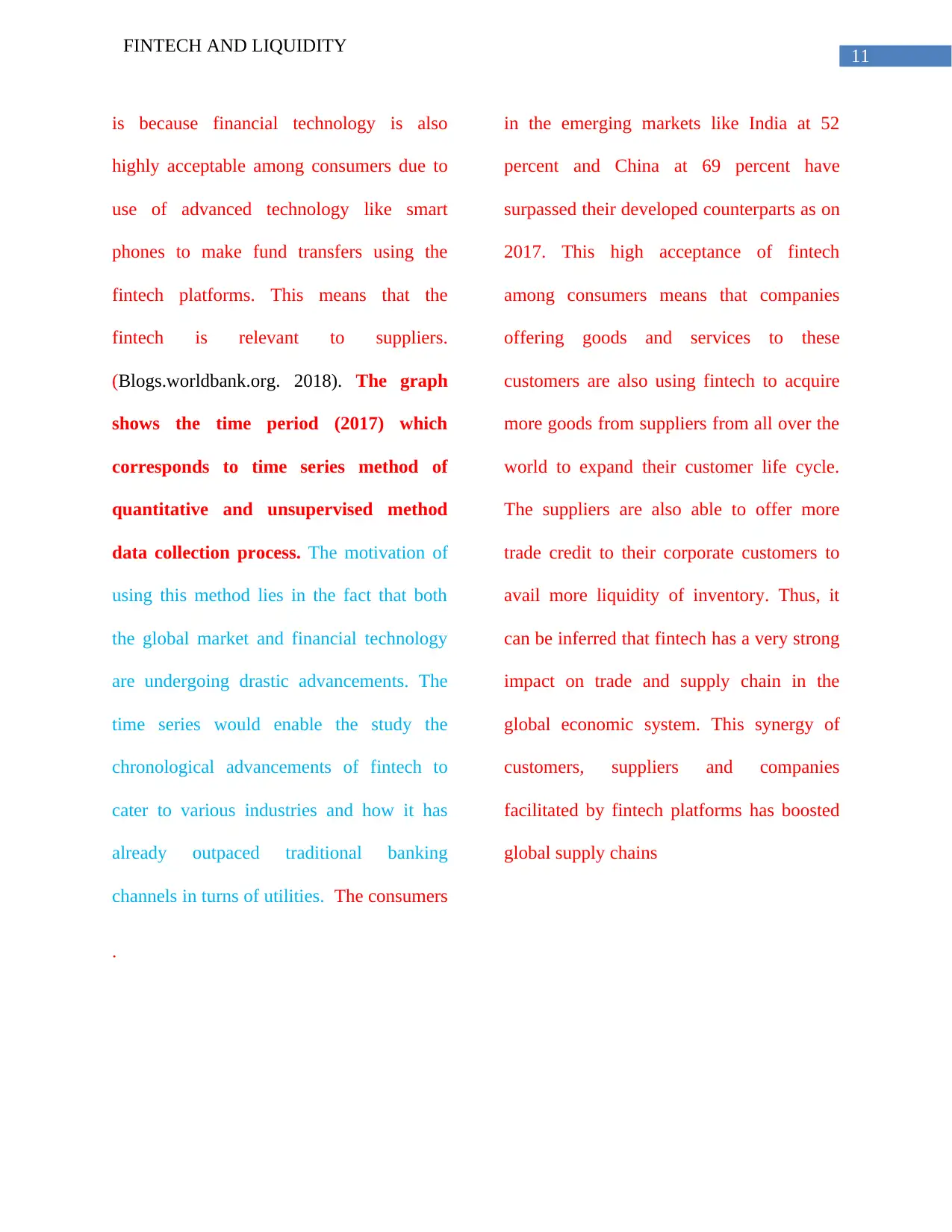
11
FINTECH AND LIQUIDITY
is because financial technology is also
highly acceptable among consumers due to
use of advanced technology like smart
phones to make fund transfers using the
fintech platforms. This means that the
fintech is relevant to suppliers.
(Blogs.worldbank.org. 2018). The graph
shows the time period (2017) which
corresponds to time series method of
quantitative and unsupervised method
data collection process. The motivation of
using this method lies in the fact that both
the global market and financial technology
are undergoing drastic advancements. The
time series would enable the study the
chronological advancements of fintech to
cater to various industries and how it has
already outpaced traditional banking
channels in turns of utilities. The consumers
in the emerging markets like India at 52
percent and China at 69 percent have
surpassed their developed counterparts as on
2017. This high acceptance of fintech
among consumers means that companies
offering goods and services to these
customers are also using fintech to acquire
more goods from suppliers from all over the
world to expand their customer life cycle.
The suppliers are also able to offer more
trade credit to their corporate customers to
avail more liquidity of inventory. Thus, it
can be inferred that fintech has a very strong
impact on trade and supply chain in the
global economic system. This synergy of
customers, suppliers and companies
facilitated by fintech platforms has boosted
global supply chains
.
FINTECH AND LIQUIDITY
is because financial technology is also
highly acceptable among consumers due to
use of advanced technology like smart
phones to make fund transfers using the
fintech platforms. This means that the
fintech is relevant to suppliers.
(Blogs.worldbank.org. 2018). The graph
shows the time period (2017) which
corresponds to time series method of
quantitative and unsupervised method
data collection process. The motivation of
using this method lies in the fact that both
the global market and financial technology
are undergoing drastic advancements. The
time series would enable the study the
chronological advancements of fintech to
cater to various industries and how it has
already outpaced traditional banking
channels in turns of utilities. The consumers
in the emerging markets like India at 52
percent and China at 69 percent have
surpassed their developed counterparts as on
2017. This high acceptance of fintech
among consumers means that companies
offering goods and services to these
customers are also using fintech to acquire
more goods from suppliers from all over the
world to expand their customer life cycle.
The suppliers are also able to offer more
trade credit to their corporate customers to
avail more liquidity of inventory. Thus, it
can be inferred that fintech has a very strong
impact on trade and supply chain in the
global economic system. This synergy of
customers, suppliers and companies
facilitated by fintech platforms has boosted
global supply chains
.
⊘ This is a preview!⊘
Do you want full access?
Subscribe today to unlock all pages.

Trusted by 1+ million students worldwide
1 out of 31
Related Documents
Your All-in-One AI-Powered Toolkit for Academic Success.
+13062052269
info@desklib.com
Available 24*7 on WhatsApp / Email
![[object Object]](/_next/static/media/star-bottom.7253800d.svg)
Unlock your academic potential
Copyright © 2020–2025 A2Z Services. All Rights Reserved. Developed and managed by ZUCOL.





